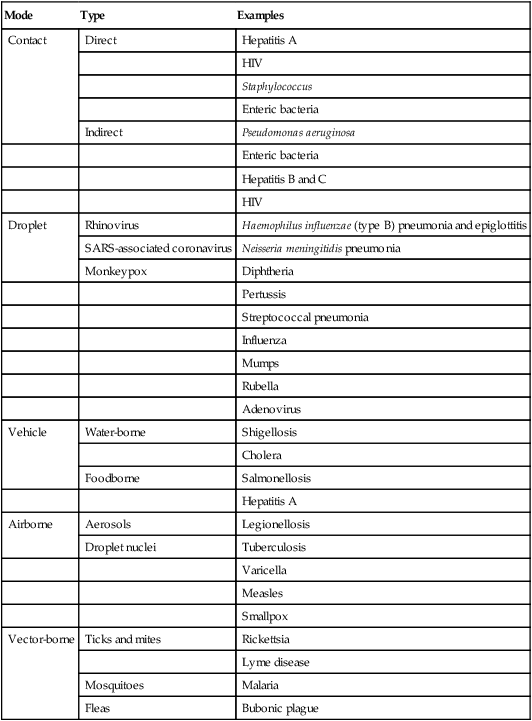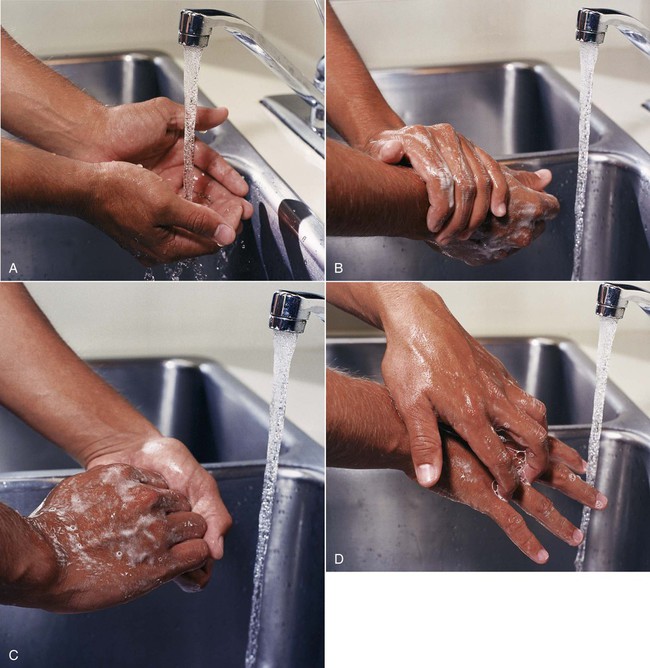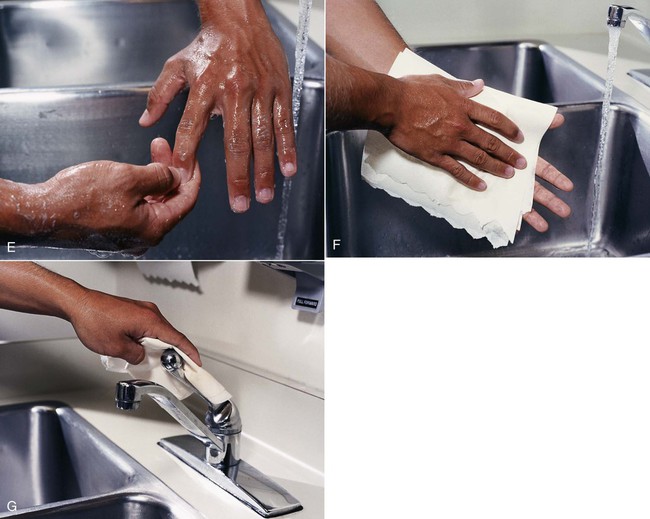Principles of Infection Prevention and Control
After reading this chapter you will be able to:
 Define health care–associated infections and state how often they occur.
Define health care–associated infections and state how often they occur.
 Describe why infection prevention is important in respiratory care.
Describe why infection prevention is important in respiratory care.
 Identify and describe the three elements that must be present for transmission of infection within a health care setting.
Identify and describe the three elements that must be present for transmission of infection within a health care setting.
 List the factors associated with an increased risk of a patient acquiring a nosocomial infection.
List the factors associated with an increased risk of a patient acquiring a nosocomial infection.
 State the three major routes for transmission of human sources of pathogens in the health care environment.
State the three major routes for transmission of human sources of pathogens in the health care environment.
 Describe strategies to control the spread of infection in the hospital.
Describe strategies to control the spread of infection in the hospital.
 Describe how to select and apply chemical disinfectants for processing respiratory care equipment.
Describe how to select and apply chemical disinfectants for processing respiratory care equipment.
 Describe equipment-handling procedures that help prevent the spread of pathogens.
Describe equipment-handling procedures that help prevent the spread of pathogens.
 State when to use general barrier measures during patient care.
State when to use general barrier measures during patient care.
Health care–associated infections (HAIs) are infections that patients acquire during the course of medical treatment. In 2002, there were an estimated 1.7 million HAIs in U.S. hospitals accounting for 99,000 excess deaths.1 Approximately 5% of all patients admitted to a hospital develop an HAI, and 15% of HAIs are pneumonias.2,3 Approximately 25% of patients undergoing mechanical ventilation develop pneumonia as a complication, and approximately 30% of these patients die as a result of lung infection.4
The seminal Institute of Medicine report identified that medical errors may be the fifth leading cause of death in the United States, with up to 100,000 deaths annually.3 At the present time, there is increasing legislative and regulatory interest in patient safety, including a focus on HAIs. Health care professionals are giving increased attention to handwashing and protecting patients against infection. The emergence of severe acute respiratory syndrome (SARS) in China in 2002 and global spread with outbreaks in health care settings and transmission to large numbers of health care personnel and patients underscore the importance of consistent adherence to infection control precautions. Similarly, infection control practices were tested in 2009 by pandemic H1N1 influenza A, reinforcing the reality that new challenges continually arise.
Spread of Infection
Three elements must be present for transmission of infection within a health care setting: (1) a source (or reservoir) of pathogens, (2) a susceptible host, and (3) a route of transmission for the pathogen (Figure 4-1).2
Susceptible Hosts
Hospital-acquired or nosocomial infections are infections that are acquired in the hospital. The high incidence of nosocomial gram-negative bacterial pneumonia is associated with factors that promote colonization of the pharynx with these organisms. Gram-negative colonization dramatically increases in critically ill patients, which increases the likelihood of the development of these pneumonias.4 Most nosocomial pneumonias occur in surgical patients, especially patients who have had chest or abdominal procedures. In these patients, normal swallowing and clearance mechanisms are impaired, allowing bacteria to enter and remain in the lower respiratory tract. Intubations, anesthesia, surgical pain, and use of narcotics and sedatives impair host defenses further. The risk of pneumonia is not the same for all surgical patients. Patients at the highest risk include elderly patients, severely obese patients, patients with chronic obstructive pulmonary disease (COPD) or a history of smoking, and patients with an artificial airway in place for long periods.5
Modes of Transmission
The three major routes for transmission of human sources of pathogens in the health care environment are contact (direct and indirect), respiratory droplets, and airborne droplet nuclei (respirable particles <5 µm). Table 4-1 provides examples of the common transmission routes for selected microorganisms.6
TABLE 4-1
Routes of Infectious Disease Transmission
| Mode | Type | Examples |
| Contact | Direct | Hepatitis A |
| HIV | ||
| Staphylococcus | ||
| Enteric bacteria | ||
| Indirect | Pseudomonas aeruginosa | |
| Enteric bacteria | ||
| Hepatitis B and C | ||
| HIV | ||
| Droplet | Rhinovirus | Haemophilus influenzae (type B) pneumonia and epiglottitis |
| SARS-associated coronavirus | ||
| Neisseria meningitidis pneumonia | ||
| Monkeypox | Diphtheria | |
| Pertussis | ||
| Streptococcal pneumonia | ||
| Influenza | ||
| Mumps | ||
| Rubella | ||
| Adenovirus | ||
| Vehicle | Water-borne | Shigellosis |
| Cholera | ||
| Foodborne | Salmonellosis | |
| Hepatitis A | ||
| Airborne | Aerosols | Legionellosis |
| Droplet nuclei | Tuberculosis | |
| Varicella | ||
| Measles | ||
| Smallpox | ||
| Vector-borne | Ticks and mites | Rickettsia |
| Lyme disease | ||
| Mosquitoes | Malaria | |
| Fleas | Bubonic plague |

Droplet Transmission
Droplet transmission is a form of contact transmission, but the mechanism of transfer of the pathogen is distinct, and additional prevention measures are required. Organisms that are transmitted by respiratory droplets include influenza and Neisseria meningitidis. Respiratory droplets are generated when an infected individual discharges large contaminated liquid droplets into the air by coughing, sneezing, or talking. Respiratory droplets are also generated during procedures such as suctioning, bronchoscopy, and cough induction. Transmission occurs when infectious droplets are propelled (usually ≤3 feet through the air) and are deposited on another person’s mouth or nose. Using the distance of 3 feet or less as a threshold for donning a mask has been effective in preventing transmission of infectious agents. However, experimental studies with smallpox and investigations of outbreaks of SARS suggest that droplets from infected patients rarely are able to reach a person 6 feet away.7 A distance of 3 feet or less around the patient is considered a short distance and is not used as a criterion for deciding when a mask should be donned to protect from exposure. Current Health Care Infection Control Practices Advisory Committee (HICPAC) guidelines state it may be prudent to don a mask when within 6 feet of a patient or on entry into the room of a patient who is on droplet isolation.6
Airborne Transmission
Airborne transmission occurs via the spread of airborne droplet nuclei. These are small particles (≤5 µm) of evaporated droplets containing infectious microorganisms that can remain suspended in air for long periods. Microorganisms carried in this manner may be dispersed widely by air currents because of their small size and inhaled by susceptible hosts over a longer distance from the source patient compared with droplet transmission. Examples of pathogens transmitted via the airborne route include Mycobacterium tuberculosis, varicella-zoster virus (chickenpox), and rubeola virus (measles). Airborne transmission of variola (smallpox) has been documented, and airborne transmission of SARS, monkeypox, and viral hemorrhagic fever virus has been reported, although it has not been proved conclusively.6
Special air handling and ventilation and respiratory protection are required to prevent airborne transmission because microorganisms may remain suspended in air and be widely dispersed by air currents before contacting a susceptible host. In addition to airborne infection isolation rooms, personal respiratory protection with National Institute for Occupational Safety and Health (NIOSH)–approved N-95 or higher respirators is required to prevent airborne transmission.6 A surgical mask, used for droplet precautions, is insufficient.
Miscellaneous Types of Aerosol Transmission
Three novel categories of aerosol transmission have been proposed following investigations of SARS transmission, as follows6:
Obligate transmission: Under natural conditions, disease occurs after transmission of the microorganism through small-particle aerosols.
Preferential transmission: Natural infection results from transmission through multiple routes, but small-particle aerosols predominate.
Opportunistic transmission: Microorganisms that cause disease through other routes but under certain environmental conditions may be transmitted via fine-particle aerosol (e.g., SARS transmission via an aerosol plume that originated from sewage in the Amoy Gardens housing complex).7
Infection Prevention Strategies
Creating a Safe Culture
Decreasing Host Susceptibility
Decreasing inherent host susceptibility to infection is the most difficult and least feasible approach to infection control. Hospital efforts at this level focus mainly on employee immunization and chemoprophylaxis. Certain immunizations are recommended for susceptible health care personnel to decrease the risk of infection and the potential for transmission to patients and coworkers within the health care facility. The Occupational Safety and Health Administration (OSHA) mandates that employers offer hepatitis B vaccination. Vaccinations of health care workers in the absence of evidence of immunity against varicella, rubella, and measles should be encouraged.8 In addition, health care personnel in facilities that care for young infants and children should receive the adult acellular pertussis vaccine. Health care personnel without medical contraindications should also receive an annual influenza vaccination.9
Antimicrobial agents and topical antiseptics may be used to prevent outbreaks of selected pathogens. Postexposure chemoprophylaxis is recommended under defined circumstances for Bordetella pertussis (whooping cough), N. meningitidis (meningococcal meningitis), Bacillus anthracis (anthrax), influenza virus, HIV, and group A streptococci.6
A large percentage of HAIs are due to device-related infections, including ventilator-associated pneumonia (VAP), catheter-related bloodstream infection, and catheter-associated urinary tract infection. The best way to decrease host susceptibility to a device-related infection is first to limit device use and second to ensure that devices are placed and maintained appropriately. Prevention bundles—defined as the use of multiple different evidence-based best practices to prevent device-related infection—have been shown to decrease the incidence of HAIs significantly.10,11 Boxes 4-1 and 4-2 list the components of the central line bundle for vascular catheter placement and the VAP bundle. Institutions should be committed to these processes of care, and individual health care workers should be familiar with these practices and execute them on a routine basis.12,13
Interrupting Transmission
General sanitation measures and equipment processing have limits. To prevent the spread of infections between patients and to keep themselves healthy, health care personnel also must take measures to stop infection. There are two tiers of HICPAC and Centers for Disease Control and Prevention (CDC) transmission precautions: standard precautions and transmission-based precautions.6
Standard Precautions
The application of standard precautions by health care personnel during patient care depends on the nature of the interaction and the extent of anticipated blood, body fluid, or pathogen contact. For some patient care situations, only gloves are required. In other cases, gloves, gowns, and face shield may be required. Box 4-3 describes standard precautions, including hand hygiene; use of gloves, masks, and eye protection; equipment handling; and patient placement.
Hand Hygiene
The importance of hand hygiene to reduce the transmission of infectious agents cannot be overemphasized and is an essential element of standard precautions.14 Hand hygiene includes handwashing with either plain or antiseptic-containing soap and water for at least 15 seconds and the use of alcohol-based products (gels, rinses, and foams) containing an emollient that does not require the use of water. In the absence of visible soiling of hands, approved alcohol-based products are preferred over antimicrobial or plain soap and water because of their superior microbicidal activity, reduced drying of skin, and convenience. The quality of performing hand hygiene can be affected by the type and length of fingernails and by wearing jewelry. Artificial fingernails and extenders are discouraged because of their association with infections.14 Figure 4-2 illustrates the proper technique for handwashing.
Gloves
Gloves protect both patients and health care workers from exposure to pathogens that may be carried on the hands of health care workers. Gloves protect caregivers from contamination when contacting blood, body fluids, secretions, excretions, mucous membranes, and nonintact skin of patients and when handling or touching visibly or potentially contaminated patient care equipment and environmental surfaces.14
Respiratory Protection
Respiratory protection (use of NIOSH-approved N-95 or higher level respirator) is intended for diseases (e.g., M. tuberculosis, SARS, smallpox) that could be transmitted through the airborne route.6 The term respiratory protection has a regulatory context that includes components of a program required by OSHA to protect workers: (1) medical clearance to wear a respirator, (2) provision and use of appropriate NIOSH-approved fit-tested respirators, and (3) education in respirator use. Information on types of respirators can be found at www.cdc.gov/niosh/npptl/respirators/respsars.html.
Gowns, Aprons, and Protective Apparel
Isolation gowns and other apparel (aprons, leg coverings, boots, or shoe covers) also provide barrier protection and can prevent the contamination of clothing and exposed body areas from blood and body fluid contact and transmissible pathogens (e.g., respiratory syncytial virus and Clostridium difficile). Selection of protective apparel is dictated by the nature of the interaction of the health care worker with the patient, including anticipated degree of body contact with infectious material.6 In most instances, gowns are worn only if contact with blood and body fluid is likely. Clinical coats and jackets worn over clothing are not considered protective apparel. Isolation gowns should always be donned with gloves and other protective equipment as indicated. As with gloves and masks, a gown should be worn only once and then discarded. In most situations, aseptically clean, freshly laundered, or disposable gowns are satisfactory.
The emergence of SARS and the ongoing concerns for pandemic infection have led to a strategy of preventing transmission of respiratory infections at the first point of contact within a health care setting (e.g., physician’s office) termed respiratory hygiene/cough etiquette that is intended to be incorporated into infection control practices as one component of standard precautions.6








